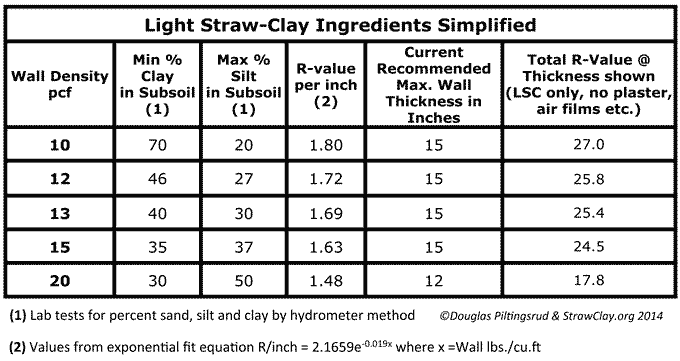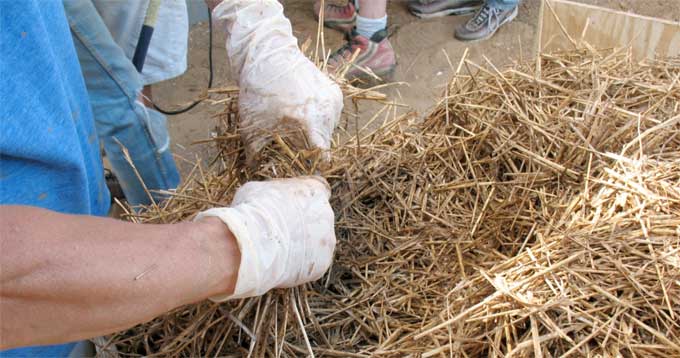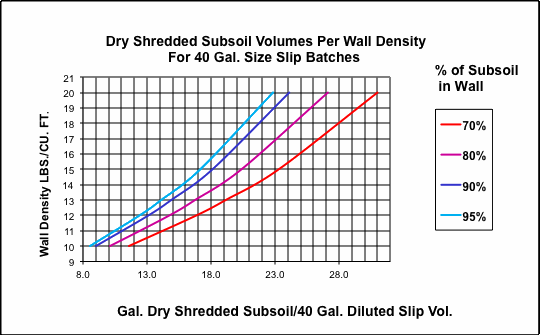|
|
 Quality Control on the Jobsite Quality Control on the Jobsite
Here we address the issue of quality control of light straw-clay mixes on the jobsite — the need for a reproducible, contractor-friendly manufacturing process to reliably make a given wall density. We do that by, 1) finding the ratio of components needed; 2) setting specifications for straw and subsoil; 3) designing the equipment and process steps to go with the process; and, 4) making the field measurements to verify and control the process.
Experimenting with the materials— straw and clay-rich subsoil with water as the carrier — we've developed recipes for mixes. Here is a basic formula for making a wall density of 13 lbs./cu.ft. (pcf). A 12- inch (30 cm) thick wall with this density will yield an insulation value of R- 20. At 15 inch (38 cm) wall thickness, the R-value would be 25.4. (See our section on R-Value for the relationship between R-value and density).
Example: 13 pcf Wall Density Formula
-
30 lbs. of straw (13.6 Kg)
-
28 lbs. of subsoil (12.7 Kg) with minimum 40% clay content, per chart below
-
58.4 lbs. of water (7 gal. or 26.5 Liters)
From experiments and field experience we've established specifications for subsoil as shown in the chart. These are based on lab soil texture analysis for percentages of sand, silt and clay. Also known as a "physical analysis", these tests are inexpensive and readily available through cooperative extension soil laboratories in most parts of the US and Canada. (An even more exacting variant of this test includes a report on "particle size distribution" per ASTM D422; it is equally accurate but is more expensive and unnecessary overkill). Note that "jar" and "clay rope" tests are very inexact for this context and cannot be relied upon to establish accurate insulation value.

We address the equipment design and process needed to accomplish highly-insulating light straw-clay mixes in our section on mixing clay slip.
With the correct testing and the equipment to make good quality clay slip, controlling the wall density in the field turns out to be quite easy. Importantly, dry straw absorbs the same amount of water each time. So all that is needed is to know how much subsoil is in the water applied ('clay slip') and a test to see if the straw has been saturated. On a jobsite, we regularly test the straw-clay mix coming out of the tumbler with the 'cigar test' and use that feedback to adjust the pace of the person loading the tumbler with straw.
The field test for saturation is simple: take up a handful of coated straw and twist it firmly into a thick 'cigar' shape. If your sample is too wet, little twisting effort will be needed to produce a drippy 'cigar'. If the 'cigar' saturation is just right however, you will need to exert some effort to force a few droplets of slip to form on the surface of the twisted, compacted straw.

We control the amount of subsoil in the water by using tanks with marked volumes, then using the chart below to choose the number of gallons of dry shredded subsoil to be dispersed. In the processes of dispersing, screening and settling that go into making the subsoil slip, some of the original dry volume is lost. This is due to rocks, gravel, sand and silt that is taken out in the process by screening and settling. This loss is adjusted for by looking at the amount of discarded subsoil in the process then picking the appropriate percentage kept line to find the gallons of that particular dry subsoil that will yield the wall density that is desired. Even with material that is just silt and clay there is some loss in slip prep and use, so the 95% line is the best choice.
. 
© 2016 Douglas Piltingsrud with Lou Host-Jablonski.
All rights reserved. This material may not be reproduced or re-used in any form without express written permission
|
|